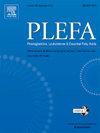Measurement of sulfidopeptide leukotrienes and their metabolism in human synovial fluid of patients with rheumatoid arthritis.
IF 2.9
4区 医学
Q3 BIOCHEMISTRY & MOLECULAR BIOLOGY
Prostaglandins, leukotrienes, and essential fatty acids
Pub Date : 1988-06-01
DOI:10.2492/JSIR1981.6.391
引用次数: 21
Abstract
Leukotriene (LT)C4 in the synovial fluid of patients with osteoarthritis deformans (OA) and rheumatoid arthritis (RA) was measured by radioimmunoassay (RIA) after extraction with Sep-Pak C18 cartridge. The amounts of immunoreactive LTC4 (i-LTC4) in samples from patients with OA and RA were not significantly different, being 0.198 +/- 0.018 pmol/ml (n = 11) and 0.179 +/- 0.016 pmol/ml (n = 12), respectively. After separation by high performance liquid chromatography (HPLC) and measurement by RIA, the levels of other sulfidopeptide LTs, such as LTD4 and LTE4, in synovial fluid from patients with RA were found to be significantly higher than those in fluid from patients with OA. The leukocyte number in synovial fluids did not correlate with the i-LTC4 level. The metabolic activities of these synovial fluids were determined by incubating them with 3H-LTC4 and then separating sulfidopeptide LTs by HPLC. The conversion of LTC4 to LTD4 in synovial fluids of patients with OA and RA were similar, but the dipeptidase activity converting LTD4 to LTE4 was higher in fluid from patients with RA. It is suggested that a high level of LTE4 may contribute to exudation of synovial fluid, since LTE4 increases vascular permeability.类风湿关节炎患者滑液中硫肽类白三烯的测定及其代谢。
用Sep-Pak C18药盒提取骨性关节炎(OA)和类风湿关节炎(RA)患者滑液中白三烯(LT)C4,用放射免疫分析法(RIA)测定其含量。OA和RA患者样本中免疫反应性LTC4 (i-LTC4)的含量无显著差异,分别为0.198 +/- 0.018 pmol/ml (n = 11)和0.179 +/- 0.016 pmol/ml (n = 12)。经高效液相色谱(HPLC)分离和RIA测定,发现RA患者滑液中其他硫肽类LTs(如LTD4和LTE4)的含量明显高于OA患者。滑液白细胞数量与i-LTC4水平无相关性。用3H-LTC4孵育后用高效液相色谱法分离硫肽类lt,测定滑液代谢活性。OA患者和RA患者滑液中LTC4向LTD4的转化相似,但RA患者滑液中LTD4向LTE4转化的二肽酶活性更高。提示高水平的LTE4可能导致滑液渗出,因为LTE4增加了血管通透性。
本文章由计算机程序翻译,如有差异,请以英文原文为准。
求助全文
约1分钟内获得全文
求助全文
来源期刊
CiteScore
6.40
自引率
6.70%
发文量
60
审稿时长
13.2 weeks
期刊介绍:
The role of lipids, including essential fatty acids and their prostaglandin, leukotriene and other derivatives, is now evident in almost all areas of biomedical science. Cell membrane behaviour and cell signalling in all tissues are highly dependent on the lipid constituents of cells. Prostaglandins, Leukotrienes & Essential Fatty Acids aims to cover all aspects of the roles of lipids in cellular, organ and whole organism function, and places a particular emphasis on human studies. Papers concerning all medical specialties are published. Much of the material is particularly relevant to the development of novel treatments for disease.

 求助内容:
求助内容: 应助结果提醒方式:
应助结果提醒方式:


